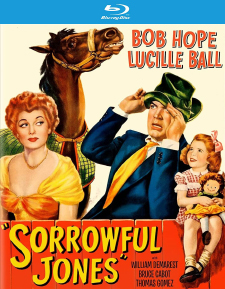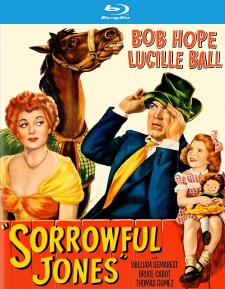Sorrowful Jones (Blu-ray Review)

Director
Sidney LanfieldRelease Date(s)
1949 (February 7, 2023)Studio(s)
Paramount Pictures (Kino Lorber Studio Classics)- Film/Program Grade: C
- Video Grade: B
- Audio Grade: A
- Extras Grade: D
Review
Damon Runyon’s short story Markie is the basis for Sorrowful Jones, the second screen adaptation of the story. The first, in 1934, was titled Little Miss Marker and starred Shirley Temple in the title role. With Bob Hope heading the 1949 cast, the screenplay was fashioned to the comic’s style by combining frequent wisecracks with the sentimental tale of a Runyonesque character who finds himself in a fish-out-of water predicament.
Sorrowful Jones (Hope) is a New York bookie known for his reluctance to part with a dollar. For a big upcoming race, he takes a bet from a gambler short on cash who leaves his young daughter Martha Jane (Mary Jane Saunders) as collateral. When the gambler fails to return, Sorrowful finds himself looking after the little girl, a job that soon throws him into a tizzy. His friend, night club singer Gladys O’Neil (Lucille Ball), takes an interest in the child and, seeing Sorrowful’s anxious, incompetent bumbling, comes around periodically with proper food and clothing for the child.
But there’s a problem. Gladys is the girlfriend of gangster Big Red Holloway (Bruce Cabot) and Big Red isn’t thrilled that Gladys is spending so much time with Sorrowful. Usually accompanied by his goons, Big Red is a dangerous guy to cross.
Meanwhile, Big Steve plans to quit horserace gambling because the racing commission is investigating him for fixing races. He intends to fix one last race so that a horse named Dreamy Joe will win and make him a fortune. To cover his tracks, he transfers ownership of Dreamy Joe to Martha Jane and after the race, he will have the horse killed.
This sets the groundwork for Sorrowful, who by now has bonded with Martha Jane, to become her protector. He places himself as well as the girl in jeopardy as they push back against Big Steve’s nefarious plan.
As in many of his films of the 1940s and early 1950s, Hope’s character is tailor-made for the comedian. Though playing a role, he’s always Bob Hope with his snappy delivery, nervous side glances, and shoulder shrugs. It gets to a point that the viewer anticipates the next joke rather than staying involved in the narrative. That might be fine for Hope fans, but those who aren’t might easily become impatient with the comedian’s upstaging his character.
A lot of the humor is based on Sorrowful’s complete ignorance of how to take care of a child. Giving her a bath, providing decent meals, and keeping her occupied become major undertakings. Hope uses young Miss Saunders as his straight man, bouncing one-liners off her at nearly machine-gun speed, but the laughs derived are sparse.
Ball as Sorrowful’s sidekick and conscience, Gladys, has few good lines of her own and, given how great she was with physical comedy, she’s oddly restrained. The role doesn’t give her much to do except serve as an awkward point on a romantic triangle of sorts. Several of her scenes offer opportunities for slapstick, but she’s made to just stand around. She’s quite obviously dubbed when she delivers the forgettable tune Having a Wonderful Wish. This was the first of four films Ball would make with with Bob Hope.
Mary Jane Saunders is adorable and manages to do the near impossible—steal scenes from Bob Hope. She’s no Shirley Temple, but being a virtual unknown contributes to her believability. She handles herself admirably in her scenes with veterans Hope and Ball.
Director Sidney Lanfield has helmed a schizophrenic film. It’s partly an extended Bob Hope routine and partly the story of a bookie who gets involved with gangsters over an unexpected acquisition—a child. The opening is promising, with its shots of a bustling Times Square and Walter Winchell’s voiceover setting the tone for the tale to follow, but the Runyon flavor fails to grace the rest of the picture.
Sorrowful Jones was shot by director of photography Daniel L. Fapp on 35 mm black-and-white film with spherical lenses and presented in the aspect ratio of 1.37:1. Kino Lorber’s Blu-ray is sourced from a 2K master and features good contrast and greyscale but doesn’t “pop” as much as other titles in their line. Process photography is used in a few scenes to suggest New York City backgrounds in this studio-filmed movie. The brief opening montage of Manhattan’s Times Square is an interesting time capsule of how the area looked over 70 years ago. Lighting lacks dramatic shadows to help with atmosphere and is fairly rudimentary.
The soundtrack is English 2.0 mono DTS-HD Master Audio. Optional English SDH subtitles are available. Dialogue is clear and sharp. Walter Winchell’s opening narration establishes the world of Damon Runyon with an off-screen voice we may remember from TV’s The Untouchables. In one scene, we hear the sounds of a brutal fight as characters in the film hear them, though the actual fight isn’t shown. Lucille Ball’s song is dubbed unconvincingly by Annette Warren, whose voice differs considerably from Ball’s speaking voice. The score by Robert Emmett Dolan is light and airy in scenes between Hope and Saunders, but fails to suggest the danger Jones is faced with later in the film. Ambient crowd noise is heard at the racetrack, and a memorable sound effect is Dreamy Joe’s hooves on the concrete street as he gallops down Broadway.
Bonus materials include the following:
- Kino Lorber Studio Classics Bob Hope Promo (4:18)
- Sorrowful Jones Trailer (2:19)
- Fancy Pants Trailer (2:13)
- Never Say Die Trailer (:55)
- The Cat and the Canary Trailer (3:40)
- Road to Singapore Trailer (2:38)
- The Ghost Breakers Trailer (2:15)
- Road to Zanzibar Trailer (2:16)
- Caught in the Draft Trailer (2:21)
- Nothing but the Truth Trailer (2:02)
- My Favorite Blonde Trailer (2:17)
- Road to Morocco Trailer (2:13)
- Road to Utopia Trailer (2:15)
- Where There’s Life Trailer (1:57)
- The Paleface Trailer (1:50)
- Alias Jesse James Trailer (2:13)
Sorrowful Jones tries too hard to get laughs. The setup is obvious, the delivery expected, and the payoff tepid at best. The biggest laugh is the sight gag of Sorrowful riding Dreamy Joe down Broadway, filmed on location with a stunt man. The Hope films that have aged best are his Road pictures with Bing Crosby. The camaraderie between Hope and Crosby was outstanding and the frequent breaking of the fourth wall is still a treat for viewers. Unfortunately, Sorrowful Jones is terribly dated and short on laughs.
- Dennis Seuling

